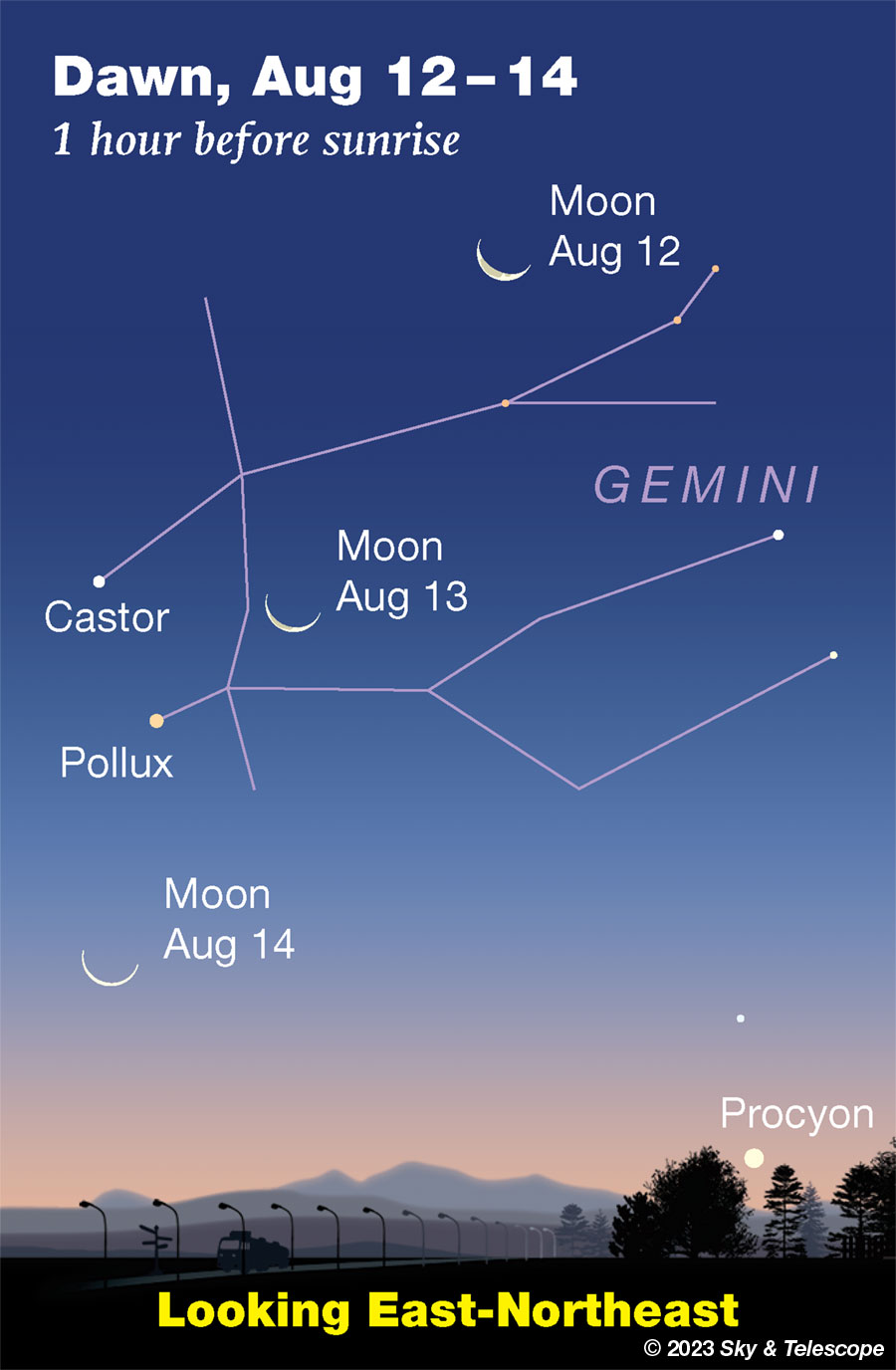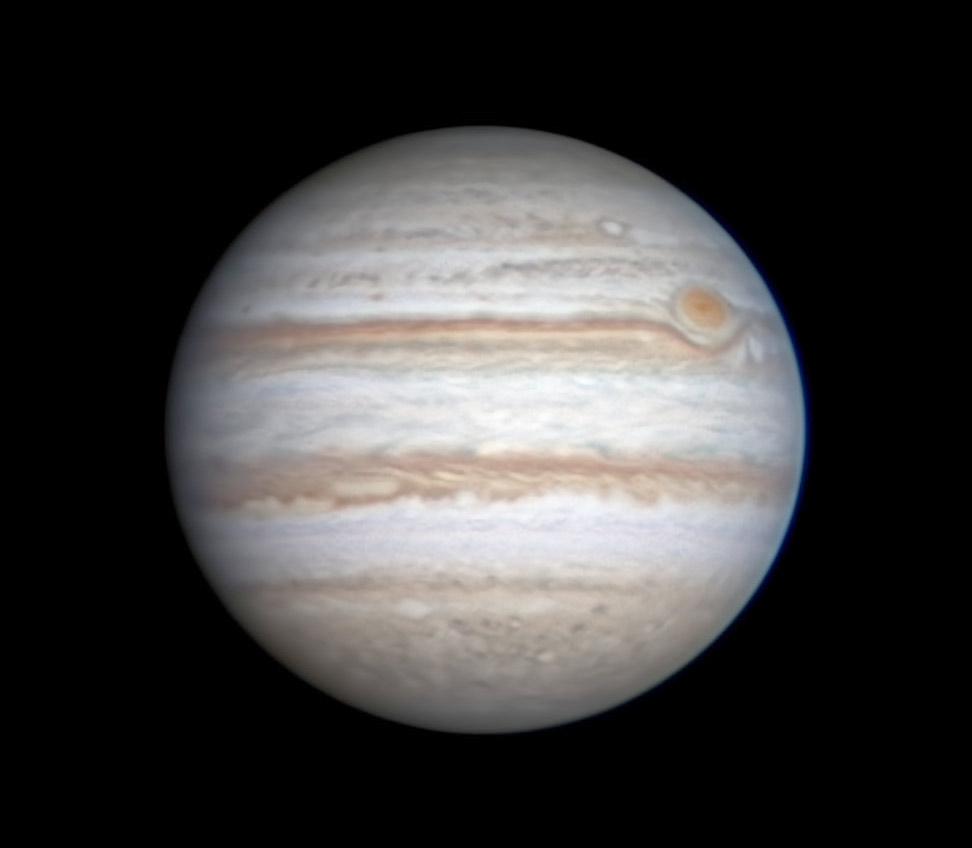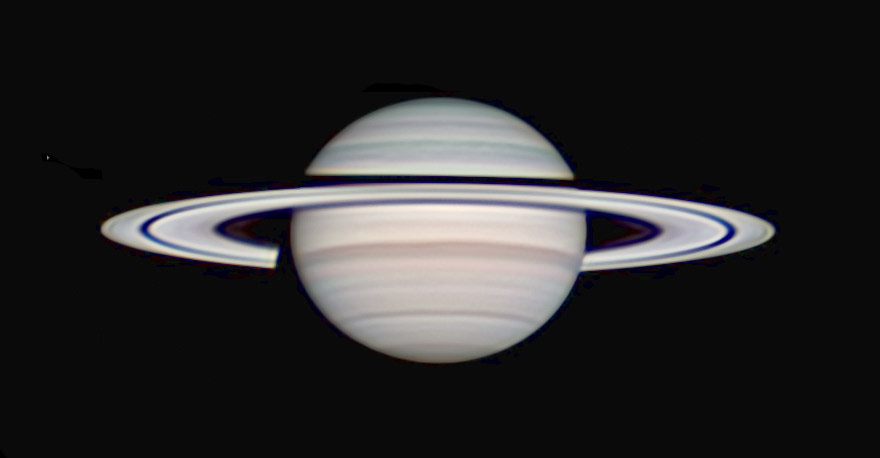FRIDAY, AUGUST 11
■ Mercury and fainter Mars, low in the west in bright twilight, remain less than 5° apart through August 16th. But they're getting harder to spot through the sunset afterglow even with optical aid.
■ After dark August is prime Milky Way time, and there's no Moon now. The Milky Way runs from Sagittarius in the south after dark, up and left across Aquila and through the big Summer Triangle very high in the east, and on down through Cassiopeia to Perseus rising low in the north-northeast.
■ Whenever Vega crosses nearest your zenith, as it does fairly soon after dark now, you know that the Sagittarius Teapot is also at its highest, due south.
Two hours later Deneb passes the zenith. That means it's the turn of boat-shaped Capricornus, and little Delphinus very high above it, to stand at their highest due south.
SATURDAY, AUGUST 12
■ The Perseid meteor shower should be at its peak late tonight, and the sky is moonlessly dark. In early evening the meteors will be few, but those that do appear will be long, lovely Earth-grazers skimming far across the top of the atmosphere. As the hours pass and the shower's radiant point (in northern Perseus near Cassiopeia) rises higher in the northeast, the meteors will become shorter and more numerous — the most so from midnight to dawn.
Layer up warmly even if the day was hot; remember about radiational cooling into a clear sky! A sleeping bag makes good mosquito armor, and use DEET on the parts of you that remain exposed.
Bring a reclining lawn chair to a dark, open spot where no local lights get in your eyes. Lie back and gaze up into the stars. Be patient. As your eyes adapt to the dark, you may see a meteor every minute or so on average when night grows late. Under light pollution you'll see fewer, but the brightest ones will still shine through.
The best direction to look is wherever your sky is darkest, usually overhead. The shower's radiant is the meteors' perspective point of origin if you could see them coming from the far distance. But you only see them in their last second or two at they hit the upper atmosphere, and that can happen anywhere in your sky.
See A Banner Year for the Perseid Meteor Shower.

SUNDAY, AUGUST 13
■ The brightest star high in the southeast these evenings is Altair, with little orange Tarazed above it by a finger-with at arm's length.
A little more than a fist-width to Altair's left is delicate Delphinus, the Dolphin, leaping left.
Above Altair, slightly less far, is smaller, fainter Sagitta, the Arrow. It too is pointing leftward.
MONDAY, AUGUST 14
A winter preview: Step out before the first light of dawn this week, and the sky displays the same starry panorama it does after dusk around Christmas. Orion is striding up in the southeast, with Aldebaran and then the Pleiades high above it. His Belt is vertical. The Gemini twins lie on their sides well to the left of Orion. Jupiter is very high in the southeast. Capella is very high in the northeast.
TUESDAY, AUGUST 15
■ As summer progresses, the Big Dipper scoops down in the northwest during evening as if to pick up the water that it will dump from high overhead early next spring.
■ Also as summer progresses, bright Arcturus moves down the western side of the evening sky left of the Dipper. Arcturus forms the bottom point of the Kite of Boötes. The Kite, rather narrow, extends upper right from it by 23°, about two fists at arm's length.
The top of the kite is bent slightly down. The kite's short tail flutters down from Arcturus.
WEDNESDAY, AUGUST 16
■ As August proceeds and nights begin to turn chilly, the Great Square of Pegasus looms up in the east, balancing on one corner. Its stars are only 2nd and 3rd magnitude, and your fist at arm's length fits inside it.
From the Square's left corner extends the main line of the constellation Andromeda: three stars (including the corner) running lower leftward, about as bright as those forming the Square.
This whole giant pattern was named "the Andromegasus Dipper" by the late Sky & Telescope columnist George Lovi. It's shaped sort of like a giant Little Dipper with an extra-big bowl, and it's currently lifting its contents upward.
THURSDAY, AUGUST 17
■ The actual Little Dipper, meanwhile, is tipping over leftward in the north. It's less than half as long as the Andromegasus Dipper, and most of it is much fainter. As always, you'll find that it's oriented more than 90° counterclockwise compared to Andromegasus. It's dumping its contents out.
FRIDAY, AUGUST 18
■ Twilight challenge. About 30 minutes after sunset, look for the thin crescent Moon very low due west. Good binoculars or a telescope might be able to show faint Mars (magnitude +1.8) just below or lower left of it (at dusk in North America). Below them, Mercury is probably too low and faint now to see at all.
SATURDAY, AUGUST 19
■ Saturn climbs well up in the southeast by 10 or 11 p.m. Look below Saturn, by about two fists at arm's length, for Fomalhaut, the Autumn Star already on its way up. No other 1st-magnitude star is anywhere near there to confuse the issue.
SUNDAY, AUGUST 20
■ The waning of August means that Scorpius, the proud starring constellation of the southern sky in July, is tilting over and lying down in the southwest after dark, preparing to bed down and drift off for the season.
This Week's Planet Roundup
Mercury and Mars are disappearing into the sunset. Both are relatively faint (magnitudes about +0.5 and +1.8, respectively). Mars is 5° above Mercury. If you want to try, use binoculars to scan for them just over the horizon due west about 30 minutes after sunset. Good luck. Although Mercury is technically brighter, it will be more dimmed by atmospheric extinction and harder to see through the sunset aftergl0w lower down. The earlier in the week you try, the better your chances.
Venus is still out of sight very low in the glow of sunrise.
Jupiter (magnitude –2.5, in Aries) rises around 11 p.m. Watch for it to come up low in the east-northeast. By the beginning of dawn Jupiter shines very high in the south.

Saturn (magnitude +0.5, in dim Aquarius) rises in twilight; it's nearing its August 26th opposition. After dark Saturn glows as the brightest thing low in the east-southeast. It's highest in the south, and sharpest and steadiest in a telescope, by about 1 a.m.

Uranus, magnitude 5.7 in Aries, is nice and high in the late-night hours, about 8° east of Jupiter.
Neptune, magnitude 7.8 at the Aquarius-Pisces border, is high after midnight, about 2o° east of Saturn.
All descriptions that relate to your horizon — including the words up, down, right, and left — are written for the world's mid-northern latitudes. Descriptions and graphics that also depend on longitude (mainly Moon positions) are for North America.
Eastern Daylight Time (EDT) is Universal Time minus 4 hours. UT is sometimes called UTC, GMT, or Z time.
Want to become a better astronomer? Learn your way around the constellations. They're the key to locating everything fainter and deeper to hunt with binoculars or a telescope.
This is an outdoor nature hobby. For a more detailed constellation guide covering the whole evening sky, use the big monthly map in the center of each issue of Sky & Telescope, the essential magazine of astronomy.
Once you get a telescope, to put it to good use you'll need a much more detailed, large-scale sky atlas (set of charts). The basic standard is the Pocket Sky Atlas (in either the original or Jumbo Edition), which shows all stars to magnitude 7.6.

Next up is the larger and deeper Sky Atlas 2000.0, plotting stars to magnitude 8.5; nearly three times as many. The next up, once you know your way around, are the even larger Interstellarum atlas (stars to magnitude 9.5) or Uranometria 2000.0 (stars to mag 9.75). And be sure to read How to Use a Star Chart with a Telescope. It applies just as much to charts on your phone or tablet as to charts on paper.
You'll also want a good deep-sky guidebook. A beloved old classic is the three-volume Burnham's Celestial Handbook. An impressive more modern one is the big Night Sky Observer's Guide set (2+ volumes) by Kepple and Sanner.
Do computerized telescopes replace charts? Not for beginners I don't think, especially not on mounts and tripods that are less than top-quality mechanically. Unless you really prefer spending your time getting finicky technology to work rather than getting to know the sky. As Terence Dickinson and Alan Dyer say in their Backyard Astronomer's Guide, "A full appreciation of the universe cannot come without developing the skills to find things in the sky and understanding how the sky works. This knowledge comes only by spending time under the stars with star maps in hand."
But finding very faint objects the old-fashioned way with charts isn't simple either. See How to Use a Star Chart with a Telescope to learn the tricks.
![]() Audio sky tour. Out under the evening sky with your
Audio sky tour. Out under the evening sky with your
earbuds in place, listen to Kelly Beatty's monthly
podcast tour of the naked-eye heavens above. It's free.
"The dangers of not thinking clearly are much greater now than ever before. It's not that there's something new in our way of thinking, it's that credulous and confused thinking can be much more lethal in ways it was never before."
— Carl Sagan, 1996
"Facts are stubborn things."
— John Adams, 1770
 2
2








Comments
Rod
August 11, 2023 at 5:30 am
Lovely early morning sky here in MD! Waning crescent Moon in Taurus near the star Elnath, Orion rising, Jupiter very bright in Aries 🙂 Much earthshine visible on the Moon this morning as I viewed unaided eyes near 0510 EDT. Stellarium shows the Moon and Elanth close to 1.5-degrees apart. The Pleiades very visible along with Auriga and Capella. Perhaps I may see some Perseid meteors in the next couple of days.
You must be logged in to post a comment.
Rod
August 13, 2023 at 10:08 pm
I was out from 2100-2200 EDT this evening. I did observe 2 bright Perseid meteors pass near Cygnus. About as bright as Deneb in Cygnus. The ISS passed over too and 3 or 4 polar orbiting satellites. Some cirrus high up. Stellarium 23.2 and Starry Night Pro Plus 8 show the meteors streak at 59 km/s compared to satellites and ISS orbiting near 8 km/s. Weather mostly clear skies, some hint of Milky Way visible in Cygnus. Temperature 23C, wind 140/2 knots, humidity = 74%.
You must be logged in to post a comment.
You must be logged in to post a comment.